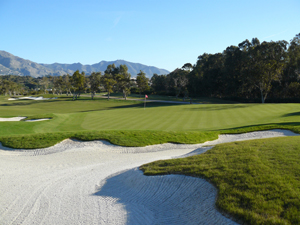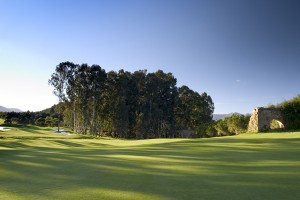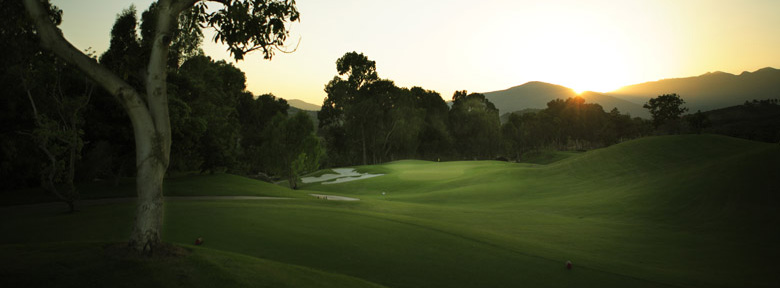Santana Golf & Country Club is an 18 Hole golf course par 72 of approx. 6203 metres (just under 7000 yards) in length,set in 138 acres of picturesque parkland. The course, sympathetically laid out by the architect Cabell B. Robinson, is set in a former avocado plantation which provided a natural solution to many problems. The final result is a magnificent course with wide and well defined fairways on level terrain, hence easily walkable, where water features play an important albeit not excessive part in the overall design.
Each hole has two championship tees and two tees for general play for both men and ladies– wide and well manicured putting greens surrounded by strategically placed bunkers, filled with sand produced from crushed marble.Buggy paths are provided throughout the course, beautifully integrated between the rows of fruit trees.
The Avocado Tree or Persea Índica -as it is known by its original name-, is not the only tree present here, as many other endemic species like eucalyptus, orange and lemon trees, cactus, pines, fig trees, olive and mango trees make up the varied vegetation of this beautiful enclave, together with a varied population of indigenous birds, with amongst others the calzada eagle. The cork oaks along the 5th hole deserve special mention, as they have been present here for more than 500 years.
 The beautiful environment with its natural surrounding will give the golfer the overriding impression of an existing maturity in every aspect of the course. However, it is not only the beauty of the landscape and its flora and fauna that will impress the player, as the golf course itself has been provided with the best attributes to please the most discerning golfer. The course has been constructed with the best means available and can boast automatic irrigation throughout the layout, as well as a sophisticated drainage system which will keep the number of days the course could be closed due to adverse weather conditions to a minimum.
The beautiful environment with its natural surrounding will give the golfer the overriding impression of an existing maturity in every aspect of the course. However, it is not only the beauty of the landscape and its flora and fauna that will impress the player, as the golf course itself has been provided with the best attributes to please the most discerning golfer. The course has been constructed with the best means available and can boast automatic irrigation throughout the layout, as well as a sophisticated drainage system which will keep the number of days the course could be closed due to adverse weather conditions to a minimum.
Santana Golf is technically speaking a demanding course as the unique design of each hole is intended to give a continuous challenge, even for the more experienced player. The layout of the greens, well protected by greenside bunkers, as well as the many water hazards spread throughout the course, will challenge every golfer and require good course management as well as the use of every golf shot in the bag. It is difficult to speak of a signature hole at Santana Golf as they all have something special to offer.
 The long Par-4 18th is one of the most demanding finishing holes along the coast according to the designer,with the lake along the right hand side and a narrow approach to the green. The 4th hole can only be defined with one word: spectacular. The views from the tee are magnificent and the ‘Campillos’ stream provides a challenging approach to the green; or what about the 8th hole, with a length of 595 metre (650 yards) considered to be the longest hole of the Costa del Sol and favouring the longer hitter; not to forget the 12th Par 3, playing downhill, with a very large undulating green, many a golfer would be happy to walk away with a three here… One of the most outstanding features of Santana Golf is without a doubt the variety in design, as each and every hole is differentiated by its own characteristics.
The long Par-4 18th is one of the most demanding finishing holes along the coast according to the designer,with the lake along the right hand side and a narrow approach to the green. The 4th hole can only be defined with one word: spectacular. The views from the tee are magnificent and the ‘Campillos’ stream provides a challenging approach to the green; or what about the 8th hole, with a length of 595 metre (650 yards) considered to be the longest hole of the Costa del Sol and favouring the longer hitter; not to forget the 12th Par 3, playing downhill, with a very large undulating green, many a golfer would be happy to walk away with a three here… One of the most outstanding features of Santana Golf is without a doubt the variety in design, as each and every hole is differentiated by its own characteristics.
To sum it all up, we are dealing here with a magnificent and spectacular course, where all these combined elements, together with the superb climate of the area and the expertise of the staff, turn Santana Golf into a course beyond your dreams, golfers’ paradise, “an area of outstanding beauty where golf and nature are one” …
INFO
Designer : Cabell B. Robinson
Course : 18 Holes
Par : 72 (36 and 36)
Lenght : 6.203 metres (just under 7000 Yards)
Type of Grass
Fairways : Tifway Bermuda Grass 419
Greens : Penncross Creeping Bentgrass
Roughs : Lolium Perenne (Rye Grass)
Buggy Paths 17.000 metres
Drainage : 16.000 metres
Water Hazards Holes 2 – 10 -15 -16 and 18 (Lakes)
Holes 4 and 7 (Arroyo Campillos)
Holes 8 (Ojén River)
Indigenous Vegetation : Avocado Tree (Persea Índica), Eucaliptus, Orange Tree, Lemon Tree, Cactus, Pine Tree, Fig Tree, Olive Tree, Mango, Cork Tree
Non-Indigenous Vegetation : Palm Trees
Indigenous Birds : Calzada Eagle, Hoopoe
Non-Indigenous Birds : Black Swans







